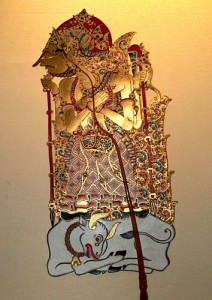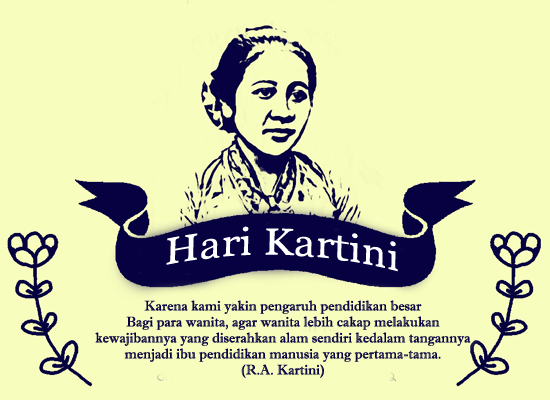Wayang or shadow puppets are inseparable from Indonesian culture. The process of making Wayang and the subsequent performance includes acting, singing, music, speech, literary, painting, sculpturing, chiseling, carving, and painting.
This art form has a very long history and continues to evolve such that Wayang is no longer just a medium for worship of (pre-Hindu), a magical-religious and education (Hindu-Buddhist era), but has now developed into a medium of revelation, preaching, education, understanding of philosophy, as well as entertainment (Islamic era until present). UNESCO recognized wayang on November 7th 2003, as World Master Piece of Oral and Intangible Heritage of Humanity.
Modernization and invasion of Western culture through television and any other medias has made young Indonesian generation is more familiar with the western culture than their own, and the younger generation in Indonesia’s major cities such as Jakarta, Bandung, Semarang and Surabaya are no longer familiar with wayang.
However, shadow puppetry and other Wayang remain popular. Leather shadow puppet shows in Central Java, such as in Yokyakarta, East Java and Jakarta (or shadow puppet shows in West Java) or in any other Java regions, are always flooded with large number of spectators. This spirit is evidence that the shadow puppet is not going to disappear because it is still loved by so many people.
Various forms of puppets are found not only in Java, but also in South Sumatra, South Kalimantan, Bali and Lombok. Wayang is a traditional art form that has flourished through the ages with some modifications through time. A puppet show showcases the local genius and the poetry and wisdom of our ancestors.
A number of artistes are required to create a puppet and in a sense this embodies the unity of aesthetic values, ethics and philosophy. The typical form of puppets, featuring the visual art and craft art has to be very aesthetically precise. The performance is based on philosophy of life and imparts noble message and teachings. All of the puppet elements, from the puppeteer to color and decoration system is a graceful lesson on goodness.
A Wayang Performance
A wayang show is a guidance on a righteous life and there is no “grey”, only contrasts: right or wrong, good or bad, reward or punishment, and so on . An affirmation of the twin elements that co-exist in this universe: day and night, male – female, black – white, good – evil.
The word Wayang is derived from the word ‘wewayangan’ which means shadow or depiction. Wewayangan puppets are about human characters – interacting between human, God’s premises, and the Creator Himself. The original Indonesian Wewayang art performances represent the human life (micro-cosmos) and its interaction with a large universe (macro-cosmos.
Although it can be argued, that the reason for the name is more to do with the technique, where the audience is behind the screen (the white cloth screen) and the puppet characters played by the puppeteers in front. Thus the audience sees the silhouette of the artistic shadows.
The traditional puppet performance has a lot of room to entertain the audience. A master puppeteer is able to incorporate the teachings of kindness with examples of actual and factual cases along with skillful singing, graceful movements and mysticism to influence the audience as a mastermind or ‘wicaksono’ or wise.
Here are some of the legendary characters in the Wayang world.
1. Rama Wijaya
In Hinduism, Rama is a famous legendary king of India who allegedly lived in the time of Tretayuga, descendant of the Solar Dynasty or Suryawangsa. He came from the kingdom of Kosala which had its capital Ayodhya. According to the Hindu point of view, it is the seventh Awatara Lord Vishnu who came to Earth in the time of Tretayuga. The figure of the famous and heroic story told in an ancient Hindu literature called Ramayana, spread from South Asia to Southeast Asia.
2. Arjuna
Arjuna is a leading figure in the shadow puppet world in the Javanese culture. Some characteristic of Arjuna puppet version may different from the Arjuna in the Mahabharata of India. In the world of puppetry, Arjuna is described as a warrior who likes to wander and studies asceticism. Besides being a student at Padepokan Sukalima Rishi Drona, he also became the pupil of Rishi Untarayana Padmanaba. Arjuna characterizes ingenuity, quiet, meticulous, courtesy, daring and savior of the weak. He led the Duchy Madukara, the territory of Amarta.
3. Hanoman
Hanuman the son of Lord Surya (God of Wind) is a white monkey in Javanese wayang, is a student and teacher. Hanoman is a character itself across generations since the time of Rama until age Jayabaya.
4. Gatotkaca
In the Javanese shadow puppet version, Ghatotkaca is very close to his cousin Abhimanyu, son of Arjuna. During the Baratayuda war, Ghatotkacha fought against Karna by confusing him. He projected himself as a thousand of people so as to make Karna feel confused. At the direction of his father, Batara Surya, Karna managed to find the original Ghatotkaca. He let go of the weapon Konta towards Ghatotkacha, and when Ghatotkacha tried to escape by flying high. However Kalabendana spirits suddenly appeared to capture Kontawijaya while conveying the news of Ghatotkacha’s death.
5. Semar
Semar’s full name is ‘Kyai Semar Badranaya’ is the main character of Javanese and Sundanese shadow puppet, Punakawan. This character is known as a caretaker and advisor of the knights the stories of the Mahabharata and Ramayana. However, Semar’s name is not be found in the original script, because this character is a creation of Javanese poets.
6. Batara Guru
Batara Guru is one of the names of mythological Mahadeva characters in Indonesia. According to Javanese mythology, Batara Guru ruled heaven, the territory of the Gods. He is the embodiment of Lord Shiva governing revelation, gifts, and various sciences. Batara Guru has a powerful (wife) named Dewi Uma and several children. Batara Guru is the only shadow puppet character which is created in forward-facing position, towards the puppeteers.
7. Bisma
Bhishma in the Indian Mahabharata and Javanese Wayang book have several differences, although the story is the same. These differences are partly due to the Javanization process, which makes the Indian epic based in the island of Java. Bisma was the son of King Santanu, king of Astina by Goddess Ganga or known as Jahnawi (the Javanese version). He was named Raden Dewabrata, as a child, which means noble descendant of Bharata. He also has another name, Ganggadata. He was one of the puppet characters called brahmacarin or celibate. Bisma lived at the Hermitage Talkanda. Bisma is depicted as a character of powerful ability. Although he is heir to the Astina throne, because of his noble desire to avoid a split in the Astina state, he was not willing to be the king.
8. Batari Durga
According to Hindu belief, Durga is the wife of Shiva. In Hinduism, the Batari Durga is the mother of Lord Ganesha and Lord Kumara. She is sometimes also called Uma or Parvati. Goddess Durga is usually depicted as a beautiful woman who rides a golden tiger. She has many arms with hands in different mudras, sacred hand gestures that are usually performed by Hindu priests. In the Javanese version at Prambanan temple in Central Java, she is also presented as Batari Durga.













